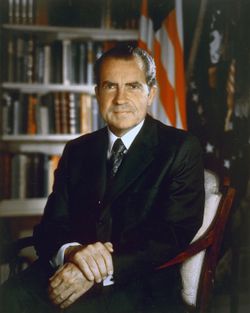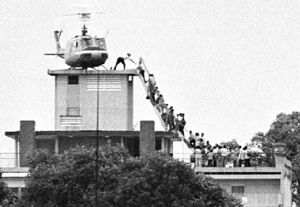How did the United States end the Vietnam War
President Richard M. Nixon assumed responsibility for the Vietnam War as he swore the oath of office on January 20, 1969. He knew that ending this war honorably was essential to his success in the presidency. He expected that the American people would give him a year to end U.S. involvement in the war, and he expected to succeed during that time—believing that his experience in foreign relations, his toughness, and his willingness to bring to bear military and political pressure on North Vietnam would yield a settlement in the public negotiations just opening in Paris.
Nixon ordered the US military to escalate the War
In his first months in office, Nixon directed the U.S. military to increase its pressure on the battlefield, while ordering the secret B–52 bombings of North Vietnamese base camps in Cambodia—the “Menu bombings”—as a signal of his willingness to further escalate the war. He expected to complement this military pressure with conciliatory negotiating terms in the newly begun negotiations, and with diplomatic pressure on the Soviet Union, hoping the Soviet Union would encourage their North Vietnamese allies to engage in serious negotiations. These forms of pressure, however, brought him no closer to ending the war.
In order to buy time with the American people, Nixon began to withdraw forces from Vietnam, meeting with South Vietnam’s President Nguyen Van Thieu on Midway Island on June 8 to announce the first increment of redeployment. From that point on, the U.S. troop withdrawal never ceased. As U.S. troop strength and capabilities declined, the United States worked toward building South Vietnam’s military capacity through a program known as “Vietnamization.” It would remain a constant question over the remaining years of the administration, whether the South Vietnamese could build the combat capability, logistics, and planning capacity, and leadership at the national and military levels to face the North Vietnamese on their own.
The Paris Peace talks between North and South were unproductive
It quickly became apparent that the public peace talks in Paris were being used as propaganda theater by both sides, and that any productive negotiations would have to be done in private. On August 4, the President’s Assistant for National Security Affairs Henry Kissinger conducted his first private session with the North Vietnamese leadership. He would meet with North Vietnamese Politburo member Le Duc Tho intermittently over the following months, with no apparent progress toward a settlement.
In the fall of 1969, disappointed with the lack of any visible results from this strategy, Nixon and Kissinger directed an extensive planning effort assessing the possibility of coercing the North Vietnamese into negotiations through a series of “short, sharp blows” inflicted by air and naval forces. The political-military planning included a cell of National Security Council staff members examining strategic issues, and a military planning team comprised of Joint Staff, Pacific Command (PACOM), and Military Assistance Command Vietnam (MACV) officers working at MACV Headquarters in Saigon.
Nixon made the "Silent Majority" speech to consolidate American support for the war
Nixon met with the Joint Chiefs of Staff (JCS) on October 11, and it became clear that the planning had satisfied neither the White House nor the JCS. With American casualties on the decline, the anti-war movement still a powerful force, and no satisfactory political-military solution in sight, Nixon turned away from that option to deliver the “silent majority” speech on November 3, 1969, rallying the American people toward patient support for a protracted war. The administration would continue its dual strategy of Vietnamization and negotiation.
United States and South Vietnam crossed in Cambodia and Laos
In March 1970 the fall of Prince Norodom Sihanouk in Cambodia destroyed the fragile neutrality of that state, as his successor Lon Nol demanded the North Vietnamese withdraw from their base camps along the South Vietnamese border. The North Vietnamese reacted by extending their presence toward the west. Nixon responded by ordering a US-South Vietnamese “incursion” into Cambodia on April 30. Limited by Nixon to a 30-kilometer strip along the border, and limited in time to the end of June, this action sparked violent protests on campuses across the United States. These culminated in the deaths of four students at Kent State University on May 4. The incursion into the North Vietnamese Army (NVA) base camps yielded a great quantity of rice, weapons, and ammunition, and disrupted the North Vietnamese command and logistics structures for months, buying time for Vietnamization and further U.S. troop withdrawals.
The following spring, Nixon ordered a theater-wide offensive, seeking to seize the initiative in the war. South Vietnamese forces crossed into Cambodia and Laos in early February 1971. The North Vietnamese had anticipated the incursion into Laos, known as Lam Son 719, and massed their forces in an attempt to annihilate the South Vietnamese. The South Vietnamese withdrawal disintegrated into a disorderly retreat. Meanwhile, Nixon and Kissinger sought to reshape the international context of the war through building relationships with North Vietnam’s superpower allies in Moscow and Beijing. Nixon wanted to create a dilemma for the Soviet and Chinese—give them “bigger fish to fry,” in his phrase—in choosing between their support of North Vietnam, and a closer relationship with the United States. The 1972 summits in Beijing and Moscow reflected this strategy, though the Communist powers continued their material support of Hanoi.
North Vietnam invaded the South
The North Vietnamese opened a three-pronged offensive in South Vietnam, known in the United States as the Easter Offensive, in late March 1972, expecting that a victory on the battlefield would translate into a triumph at the negotiating table. Rather than accept the prospect of defeat, Nixon sent massive air force and naval reinforcements to bases in Indochina and Guam.
On May 4 he decided to mine North Vietnam’s harbors and open a sustained air offensive, Operation Linebacker, against North Vietnam. These actions, along with intensive air attacks in the battle areas and improved South Vietnamese defenses, stymied North Vietnam’s offensive, leading the Politburo, for the first time, to engage in serious negotiations.
Kissinger and North Vietnam came to an agreement, but South Vietnam rejected it
On October 11–12 Kissinger and Le Duc Tho reached agreement on a peace settlement, both sides working to reach that end before the U.S. presidential election on November 7. President Thieu rejected the settlement, refusing to accept a peace that left North Vietnamese forces in South Vietnam, and legitimized the Hanoi-controlled Communist shadow government, the Provisional Revolutionary Government.
His rejection forced Kissinger to resume negotiations with Le Duc Tho. Kissinger was unable to find any common ground acceptable to both Vietnamese parties in two renewed rounds of negotiations. Finally, in order to break the deadlock, on December 14 Nixon ordered massive B–52 attacks on the North Vietnamese heartland—the “Christmas Bombing.” Meanwhile he continued to exert intense pressure on Thieu, threatening to cut off U.S. economic, military, and political support of South Vietnam if Thieu refused to accept the agreement.
Negotiations finally led to a deal
Negotiations resumed on January 8, 1973, and the United States and the Democratic Republic of Vietnam initialed the agreement on January 23. Thieu reluctantly accepted the settlement despite his continued misgivings, and the peace agreement was signed on January 27. The peace settlement enabled the United States to withdraw from the war and welcome the American prisoners of war back home. Neither of the Vietnamese parties abided by the settlement, however, and the war continued.
Nixon had gained Thieu’s adherence to the agreement through a series of letters and envoys, all promising U.S. military support in the event of a North Vietnamese violation of the accords. On November 14, 1972, for example, Nixon wrote Thieu that “I repeat my personal assurances to you that the United States will react very strongly and rapidly to any violation of the agreement.” Both sides understood this to mean the recommitment of B–52s to combat.
Conclusion
In the end, these commitments were not upheld due to a combination of factors—domestic and Congressional reluctance to re-engage in the war, economic constraints, and finally the Watergate scandal, which weakened and distracted Nixon. Having rebuilt their forces and upgraded their logistics system, North Vietnamese forces triggered a major offensive in the Central Highlands in March 1975. On April 30, 1975, NVA tanks rolled through the gate of the Presidential Palace in Saigon, effectively ending the war.
- Republished from Office of the Historian, United States Department of State
- Article: Ending the Vietnam War, 1969–1973

